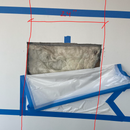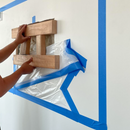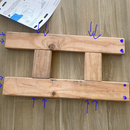small framing question for tv mount
Just opened up my walls and realized the steel studs are 24 OC and the stud wall is about 2 inches wide only plus sheetrock making it 4 inches.
The tv mount I bought is made for 16 inches and I was planning on building this bracket to install the tv mount.
Just wondering if I could screw the bracket diagonally into the studs or the best way to do this?
Was planning to use black sheetrock screws for the front of the stud attached to the larger piece on the right side and then the same screws on the side of the steel stud into the side of the stud. The top and and bottom would have these long screws from the top and bottom for the 2 pieces in the middle so the framing doesnt buckl to much.
Is this over kill and I only really need the 2 horizontal pieces of wood and attach those to the stud?
GBA Detail Library
A collection of one thousand construction details organized by climate and house part












Replies
The usual way to do this for an exposed piece of wood is to use a hardwood board. I would use a piece of oak, probably a 1x10 or 1x12, whatever you need to get the right amount of space for the mount. If you want to do a really nice job of things, you can use carriage bolts through the oak from the back with acorn nuts on the mount.
I would NOT use drywall screws to secure the mount to the studs. Use heavier screws, probably #10, and four or more per side. There is a LOT of force on these screws, so it needs to be secure. Even better would be to put something inside the wall to anchor to sandwich style, but this can be tricky.
There is an easier way though... Go on Amazon and look up mounts by Echogear -- they make mounts that are already made to fit 16" AND 24" stud spacing. So much easier that way :-) I have a number of their mounts myself and I've been happy with them, although you do need to really tighten down the tild adjust screw as that's a weak spot, so it's easy for the TV to tilt down.
Bill
Thanks Bill!
Since these are 2 inch metal studs at 24 inch wide will the mount that works for 24 inch be enough? to hold the tv up? its also just a single piece of sheetrock. I will have 2 tvs almost back to back both are very thin but 65 inchs each.
It wont bring my wall down if I have tv on both sides on separate studs sharing 1 stud in the middle though right?
Will probably go your route and find a 24 inch mount but would need it to be full motion mount. If I just use a 24 inch mount the screws they give you should be sufficient I assume. And it would only be 4 screws at the corners then.
Looking into it most of them say wood studs and dont have a metal stud option.
https://www.amazon.com/ECHOGEAR-Motion-Articulating-Mount-Bracket/dp/B073QX1ZMS/ref=sr_1_1_sspa?keywords=echogear+tv+mount&qid=1660264725&refinements=p_85%3A2470955011&rnid=2470954011&rps=1&sprefix=echogear%2Caps%2C75&sr=8-1-spons&ufe=app_do%3Aamzn1.fos.f5122f16-c3e8-4386-bf32-63e904010ad0&psc=1
Thanks.
Look at "TOGGLER", your local box store should have it. You do need to drill a pretty big 1/2" hole to fit it but it is very solid. Instead of going into drywall, for extra hold find exactly the middle of the stud and drill there. Sometimes with thin walls there is not enough space for the metal bit to toggle, definitely the case for 1 5/8 metal studs, in that case you can cut off a bit of the metal ears with an angle grinder to shorten it.
Do you think I could just add wood to the metal stud like a small maybe 12 inch woof inside the stud. Screw that into the metal stud and then install the tv nount bracket into the wood/metal stud?
Or is the toggler enough if I just go into the metal stud with the toggler.
https://cdn2.tmbi.com/TFH/Step-By-Step/display/FH01FEB_STEELS_06.JPG
Sure, if you don't mind cutting into the wall. The metal studs will have a small lip so the wood won't sit flat. You can either cut the lip and bend it flat or do a kerf cut into the lumber to make room for it.
The combination of lumber and metal stud is very solid.
The reason the mounts don't talk about metal studs much is because most houses are wood framed, so wood studs are more common, and metal studs don't hold screws as well since there is just a little bit of sheet metal for the screw's threads to bite into. Those are not insurmountable problems though, you just have to know how to deal with things to be able to hang the mount successfully in a safe manner.
+1 for those Toggler anchors that Akos mentioned. I have used those many, many times and they work well. Just try not to get too much drywall dust and paper bits in the threads, and make sure they are seated flat against the inside of the wall prior to trying to thread the bolt in. DO NOT trust them for a TV mount in drywall alone though -- BE SURE they are going into the studs as Akos mentioned. Drywall alone is not sufficiently strong for a TV mount, especially a full motion mount. Remember that a full motion mount acts as a lever to magnify the forces exerted on the wall by the weight of the TV, so it's extra critical to securely mount such mounts. In my own home, I have an 85" TV on one of the bigger Echogear full motion mounts, and I used their provided lag screws (bolts, basically, but with wood threads) to secure it to two studs. It's very solid this way.
In your situation, my preferred method would be to open up the wall directly behind the TV where it will be hidden from view once the TV is in place. I would cut a notch lengthwise into two 2x4 sections as Akos mentioned so that the 2x4 can fit flat against the wall over the inside lip of the stud. I would not hammer or cut the lip on the metal stud, you want that to maintain maximum rigidity here. I would put in 2x4 pieces at least a foot long, but ideally longer (longer spreads the load over a larger area), vertically on each stud the mount will be secured to. The idea is to provide 2x4 material for the lag screws to screw into.
Once you have those braces set inside the wall, secure them with a drywall screw or two so that they stay in place. You want them placed so that the TV mount will be in the approximate center of each brace vertically, and you want the TV mount to go through the stud on either side and into the wooden brace behind the stud. This way the wood allows the lag screw to securely hold, and the wood spreads the load out over a larger area of the stud. Both things help to make the mount more secure.
Drill the holes for the mount normally at this point, being sure to go through the stud in the approximate middle of the edge of the stud, into the wood. You can drill the normal size pilot hold recommented for the lag screw you're using. Next step is to mount the TV mount in the usual way, since your wood braces essentially convert the metal studs to wooden studs from the perspective of the TV mount. You can either close up the wall with some drywall, or leave it open since the TV will conceal it. Note that if your dryall is supposed to be your air barrier you'll need to close up the hole.
There is a potentially easier way to go if you have TVs on opposite sides of the same wall: you can use machine screws to go all the way through the wall, secureing the mounts on both sides. In this case, drill through the studs (this is imperative, you MUST be in the steel studs, NOT in drywall alone), but go straight through the wall so that you have a common hole straight through both sides of the wall and the stud between. You'll probably need to do this four times, lining up the holes with the mounting pattern of the TV mount. You can now use long bolts to go through the first mount, then the wall, then the second mount, and now some nuts to secure the entire thing. I would use flat washers too, so arrangement would look like bolt head / flat washer / mount #1 / drywall / front stud edge / air space / back stud edge / drywall / mount #2 / flat washer / nut. This will make a very secure mount just don't overtighten since you could crush the wall. I would use 1/4" bolts here, or possibly 1/4-20 threaded rod with a nut on either end. The advantage to 1/4" threaded rod is that you can cut it to whatever length you need. The disadvantage to threaded rod is that it's easy to mess up the threads so that it's hard to get the nut on.
If you go with threaded rod, I've found it cuts more cleanly with a sawzall or hacksaw than bolt cutters. Screw a nut on first, then make your cut, then back the nut off over the cut to clean up the threads. If you can find grade 5 threaded rod (which does exist, but you usually need to order it), it will be MUCH nicer to work with in terms of the threads not getting messed up when you cut it.
Old telecom guy trick: Immediately after cutting the threaded rod, give the cut end a quick light coat of spray paint. This will provide some rust protection, and the paint will dry quickly while the cut end is still warm from cutting. I have done this many (thousands) of times, and it works well.
It will be easier to use regular bolts if you can find the length you need in stock. I recommend you use a nylock nut instead of regular nut for some extra safety. A nylock nut as a nylon insert in it that helps to prevent the nut from loosening over time and possibly coming off the bolt or threaded rod. Nylocks are easy to find in hardware stores, so it's some cheap extra insurance.
Bill
This is so detailed Bill. Thank you!
Seems the quickest easier way with the materials I already have would be to get a 16 inch piece of wood stud to fit inside the channels of the metal stud (metal stud is 2.5 inch wide so im assuming 2.5 inch x 1 inch x 16 inch wood stud) will fit very snug inside the metal stud. then im going to use plywood and nail that to the front of the stud in place of sheetrock compund and sand and paint.
Then put the tv mount and screw that using the wood screws provided into the middle of the metal stud where the wood is.
#10 screws as you suggested from the metal stud face into the wood that sits inside its flange and channel and then another set of #10 screws for the plywood into the metal stud.
1" wood might split. If you have to use such small dimension wood pieces, you might consider a light hardwood such as poplar that may prove to be more durable. The reason Akos and I suggested 2x4 is that 2x4s are less likely to split, but are still inexpensive and relatively easy to work with. You can create the notch we talked about by using a circular set to a shallow depth of cut and using a guide to keep the line straight. The width of the blade -- the kerf -- will cut a wide enough channel to clear the lip of a metal stud without any trouble. If you cut the notch down a piece of 2x4 first, then cut the 2x4 into the sections you need, you'll only have to do the setup to cut that notch once instead of twice, which will save you some time.
If you use plywood, I'd probably use short 1/4" lag screws to hold the mount to the plywood. The reason for this is that larger diameter screws tend to hold better in thinner wood. You can use smaller screws to hold the plywood to the wall, since you can use more screws to make up for the weaker per-screw holding power.
Bill
Thanks Bill,
Not sure if this is what you meant but i drew it out since I have tvs on both sides of the wall but they will share a stud in the middle. I dont think Ill be able to fit both sides with wood on the stud they are but did you mean something like the attached diagram?
Red: metal framing
Blue: 2x4 laid flat inside the side with a small cut so the flange sits in there
Black: sheetorck or plywood but will probably use plywood
Green: is the TV mount.
Someone below suggested i just use 1/2 inch plywood and just nail it to the stud and just nail the tv mount thats 16 in OC into the plywood and no need to on the studs. is that strong enough because thats probablyt the quickets route. But your diagram above seems to be more safe and the "Correct" way to do things.
If you've already cut the drywall away I would just cut a piece of 1/2" plywood to fill the hole, screw it to the studs and then screw the mount to the plywood.
Hi DC,
the mount wouldnt be attached to the stud and only the plywood. or did you mean for me to get the 24 inch mount and just put that onto the plywood. and the stud
Is that strong enough? Dont want my fall falling foward on either sides haha. This would def be the easiest for me.
Just have a tv on both sides of the wall. the mount is 20-25lbs. and the tv is 70 lbs.
Right, the mount is attached only to the plywood.
I dont need to pull wood on the entire metal stud right? I could put a 12 inch piece on the insides of the channel which should be enough right? Screw that into the stud using #10 screw bill suggested and then use whatever wood screws the tv mount comes with into that wood/metal stud.
You only need some wood in the channel of the stud. The wood is there mainly to provide something for the lag screws to hold onto, the metal stud itself is providing the vertical support.
Bill
You have already cut the drywall, so no matter what you are patching that, so may as well do this correctly.
You want to add blocking into the wall. 3 5/8" is a standard metal stud size as is 2.5, but if those are 2.5 studs at 24 oc, they may be cold formed steel rather than LGMF. Google a bit on how to add blocking to a metal stud wall. You should add your blocking for both TV's from the same side. Might have to cut a bit larger hole to get the plates in there. Code probably requires you use fire treated wood (not the same as pressure treated). You may have to go to the lumberyard to get some. You can use 2x or plywood. You also want a few metal plates to slide between the framing and the gyp this will help ensure the wood blocking is well attached to the studs. You can drive your fasteners right through the gyp in through the plate, the framing and your blocking.
Watch out for the BX conduit in that wall - don't hit it with your fasteners.
For next time, Monoprice makes some TV mounts that only mount to a single stud, which can be a metal stud.